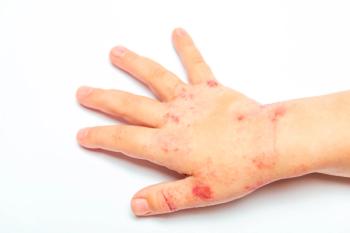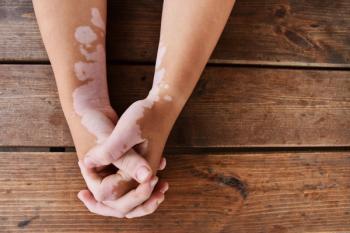
Using dupilumab for pediatric alopecia areata
Hair regrowth was observed after starting dupilumab treatment in some pediatric patients with a history of severe and refractory alopecia areata and concomitant atopic dermatitis.
Findings of a retrospective review of pediatric patients add to existing evidence suggesting a role for dupilumab (Dupixent; Sanofi/Regeneron Pharmaceuticals, Inc) as a systemic treatment for severe and refractory alopecia areata (AA).
In a letter published in the Journal of the American Academy of Dermatology, Leslie Castelo-Soccio, MD, PhD, reported on 16 children with coexisting atopic dermatitis (AD) and AA who were receiving subcutaneous dupilumab 300 mg every 2 weeks.1 Four children also had concurrent asthma.
Dupilumab was well tolerated and appeared safe in this small series of patients. The only adverse events were mild injection-site reactions.
Responses of patients with AA after starting dupilumab varied. Improvement occurred in 4 of 6 patients with flaring/active AA, and hair regrowth was seen in one additional patient. Six patients maintained hair regrowth. Among patients who experienced benefit, the Severity of Alopecia Tool (SALT) score improved by an average of 33.3 after 12 months.
“A single center trial [NCT03359356] at the Icahn School of Medicine at Mount Sinai led by Emma Guttman-Yassky, MD, PhD investigating dupilumab for treating AA in adults with and without concomitant AD has been completed, and the results should be available soon,”2 Castelo-Soccio, an assistant professor of pediatrics and dermatology at the University of Pennsylvania Perelman School of Medicine and dermatologist at Children’s Hospital Of Philadelphia in Philadelphia , Pennsylvania told Dermatology Times®. “I am continuing to use dupilumab to treat children with AA if it is comorbid with atopic disease for which benefits of dupilumab are clear, but a clinical trial investigating its use to treat AA in children is needed.”
Treatment Rationale
Interest in dupilumab as a treatment for AA and an explanation for its possible benefit is supported by genome-wide association studies investigating susceptibility loci for AA that showed an interleukin (IL)-13 signature in some patients.3
“Dupilumab could control the inflammatory response in AA and help with AA flares because it blocks the IL-13 signaling pathway by binding to the IL-4Rα subunit shared by the IL-4 and IL-13 receptor complexes,” Castelo-Soccio explained.
Castelo-Soccio said she cares for many pediatric patients with AA in her patient population and that many of these patients who have concurrent atopic disease report that they experience AA flares whenever their eczema or atopic rhinitis flares.
“Dupilumab was being used more broadly at our center for treating children with severe AD, and anecdotally, I had noticed hair regrowth and reduction in flares among patients who also had AA,” Castelo-Soccio noted. “I undertook this retrospective review to get a clearer idea of how AA was responding.”
Data Details
Among the 16 patients included in the review, the duration of AA prior to starting dupilumab ranged from less than 1 year to 11 years. Median number of prior therapies for AA was 4, and 8 children were on 1 or more additional therapies while being treated with dupilumab.
Types of AA among the 16 children included universalis (n = 7), ophiasis (n = 5), and patchy (n = 4). The AA was active in 6 patients. SALT scores at dupilumab initiation ranged from 0 to 100. The 2 patients with active disease who did not respond to dupilumab had SALT scores of 100 when starting dupilumab.
In 4 patients, AA worsened during the first 1 to 2 months after starting dupilumab, but it improved with time in the 2 patients who had further follow-up—and both patients had a SALT score of 0 at 12 months after starting dupilumab. Two patients with SALT scores of 0 when starting dupilumab were already receiving tofacitinib and were able to undergo dose reduction of the Janus kinase inhibitor without increased hair loss.
Exploring potential characteristics associated with a better response, Castelo-Soccio observed that all the patients who improved had moderate to severe AD when starting dupilumab. Compared to the nonresponders, the responders had a lower median age at AD diagnosis (6 years vs 13 years) and a longer median duration of AD (6 years vs 1 year).
“A previous report also found that patients whose AA responded to dupilumab had more severe and long-standing histories of AD,”3 Castelo-Soccio said.
General Considerations
AA is the most prevalent autoimmune disorder, and comorbidity of atopic disease and AA is not uncommon.4 An analysis limited to children with AA found that 26.6% had atopy.5
Castelo-Soccio said that standard therapy for AA in children includes topical steroids and topical sensitizers, along with selected use of intralesional triamcinolone. Systemic therapy is considered for children with extensive hair loss (> 30% to 50%) or for those with less area of involvement but who are experiencing significant quality-of-life impairment because of the disease.
“Ultimately, the decision to use systemic medications in children is made jointly with the family and child following a thorough discussion of the benefits and risks,” Castelo-Soccio said. “I always remind families that we are treating the child and not the parents or guardians. In addition, I emphasize that AA is a medical disease and should be treated like one but that the visibility of the disease creates an enormous psychological burden, and so care addressing this part of the medical disease is also needed.
“The options for systemic therapy include steroids, methotrexate, Janus kinase inhibitors, or dupilumab. However, I do not think dupilumab is effective in children without an atopic component.”
Disclosures
Castelo-Soccio has no relevant financial interests to disclose.
References
1. McKenzie PL, Castelo-Soccio L. Dupilumab therapy for alopecia areata in pediatric patients with concomitant atopic dermatitis. J Am Acad Dermatol. 2021;84(6):1691-1694. doi:10.1016/j.jaad.2021.01.046
2. Treatment of alopecia areata (AA) with dupilumab in patients with and without atopic dermatitis (AD). ClinicalTrials.gov. Updated January 7, 2021. Accessed June 9, 2021.
3. Jagielska D, Redler S, Brockschmidt FF, et al. Follow-up study of the first genome-wide association scan in alopecia areata: IL13 and KIAA0350 as susceptibility loci supported with genome-wide significance. J Invest Dermatol. 2012;132(9):2192–2197. doi:10.1038/jid.2012.129
4. Marks DH, Mesinkovska N, Senna MM. Cause or cure? review of dupilumab and alopecia areata. J Am Acad Dermatol. Published online June 13, 2019. doi:10.1016/j.jaad.2019.06.010
5. Villasante Fricke AC, Miteva M. Epidemiology and burden of alopecia areata: a systematic review. Clin Cosmet Investig Dermatol. 2015;8:397-403. doi:10.2147/CCID.S53985
Newsletter
Access practical, evidence-based guidance to support better care for our youngest patients. Join our email list for the latest clinical updates.









